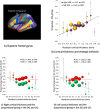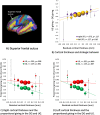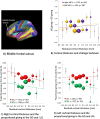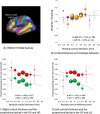Cortical thickness of the dorsolateral prefrontal cortex predicts strategic choices in economic games
- PMID: 27140622
- PMCID: PMC4878491
- DOI: 10.1073/pnas.1523940113
Cortical thickness of the dorsolateral prefrontal cortex predicts strategic choices in economic games
Abstract
Human prosociality has been traditionally explained in the social sciences in terms of internalized social norms. Recent neuroscientific studies extended this traditional view of human prosociality by providing evidence that prosocial choices in economic games require cognitive control of the impulsive pursuit of self-interest. However, this view is challenged by an intuitive prosociality view emphasizing the spontaneous and heuristic basis of prosocial choices in economic games. We assessed the brain structure of 411 players of an ultimatum game (UG) and a dictator game (DG) and measured the strategic reasoning ability of 386. According to the reflective norm-enforcement view of prosociality, only those capable of strategically controlling their selfish impulses give a fair share in the UG, but cognitive control capability should not affect behavior in the DG. Conversely, we support the intuitive prosociality view by showing for the first time, to our knowledge, that strategic reasoning and cortical thickness of the dorsolateral prefrontal cortex were not related to giving in the UG but were negatively related to giving in the DG. This implies that the uncontrolled choice in the DG is prosocial rather than selfish, and those who have a thicker dorsolateral prefrontal cortex and are capable of strategic reasoning (goal-directed use of the theory of mind) control this intuitive drive for prosociality as a means to maximize reward when there are no future implications of choices.
Keywords: DLPFC; dictator game; prosocial behavior; strategic reasoning; ultimatum game.
Conflict of interest statement
The authors declare no conflict of interest.
Figures








Similar articles
-
Decoding fairness motivations from multivariate brain activity patterns.Soc Cogn Affect Neurosci. 2019 Nov 1;14(11):1197-1207. doi: 10.1093/scan/nsz097. Soc Cogn Affect Neurosci. 2019. PMID: 31916582 Free PMC article.
-
Response time in economic games reflects different types of decision conflict for prosocial and proself individuals.Proc Natl Acad Sci U S A. 2017 Jun 13;114(24):6394-6399. doi: 10.1073/pnas.1608877114. Epub 2017 May 30. Proc Natl Acad Sci U S A. 2017. PMID: 28559334 Free PMC article.
-
Role of the prefrontal cortex in prosocial and self-maximization motivations: an rTMS study.Sci Rep. 2021 Nov 16;11(1):22334. doi: 10.1038/s41598-021-01588-6. Sci Rep. 2021. PMID: 34785670 Free PMC article.
-
Improving the measurement of prosociality through aggregation of game behavior.Curr Opin Psychol. 2022 Apr;44:237-244. doi: 10.1016/j.copsyc.2021.09.018. Epub 2021 Sep 30. Curr Opin Psychol. 2022. PMID: 34749241 Review.
-
How reinforcer type affects choice in economic games.Behav Processes. 2007 Jun;75(2):107-14. doi: 10.1016/j.beproc.2007.02.001. Epub 2007 Feb 8. Behav Processes. 2007. PMID: 17353099 Review.
Cited by
-
Beliefs about others' intentions determine whether cooperation is the faster choice.Sci Rep. 2018 May 14;8(1):7509. doi: 10.1038/s41598-018-25926-3. Sci Rep. 2018. PMID: 29760504 Free PMC article.
-
Reduced orbitofrontal cortical volume is associated with interdependent self-construal.Proc Natl Acad Sci U S A. 2017 Jul 25;114(30):7969-7974. doi: 10.1073/pnas.1704831114. Epub 2017 Jul 12. Proc Natl Acad Sci U S A. 2017. PMID: 28701382 Free PMC article.
-
A neurocognitive mechanism for increased cooperation during group formation.Commun Psychol. 2024 Dec 23;2(1):127. doi: 10.1038/s44271-024-00177-3. Commun Psychol. 2024. PMID: 39715935 Free PMC article.
-
A dual-fMRI investigation of the iterated Ultimatum Game reveals that reciprocal behaviour is associated with neural alignment.Sci Rep. 2018 Jul 18;8(1):10896. doi: 10.1038/s41598-018-29233-9. Sci Rep. 2018. PMID: 30022087 Free PMC article.
-
Transdiagnostic neural correlates of volitional emotion regulation in anxiety and depression.Depress Anxiety. 2019 May;36(5):453-464. doi: 10.1002/da.22859. Epub 2018 Nov 8. Depress Anxiety. 2019. PMID: 30408261 Free PMC article.
References
-
- Bowles S, Gintis H. A Cooperative Species. Princeton Univ Press; Princeton: 2011.
-
- Nowak M. SuperCooperators: Altruism, Evolution, and Why We Need Each Other to Succeed. Free Press; New York: 2011.
-
- Tomasello M, Melis AP, Tennie C, Wyman E, Hermann E. Two key steps in the evolution of human cooperation: The interdependence hypothesis. Curr Anthropol. 2012;53(6):673–692.
-
- Mead G. Mind, Self, and Society. University of Chicago Press; Chicago: 1934.
Publication types
MeSH terms
LinkOut - more resources
Full Text Sources
Other Literature Sources

